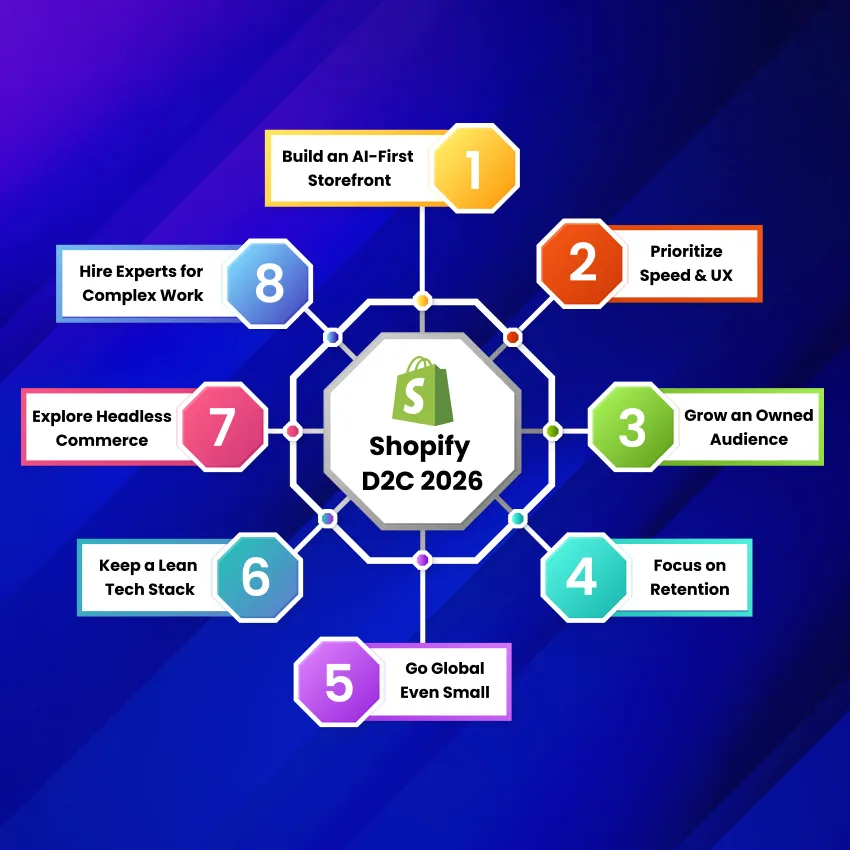
2026 will reshape how D2C brands grow on Shopify. AI will automate nearly half of store operations, paid ads will lose reliability, and owned audiences and retention will finally take center stage. Shopify will push deeper into headless commerce, personalization, and global selling.
So if a brand wants to scale next year, they need to create and implement a Shopify Growth Strategy 2026 that focuses on speed, personalization, smart data use, and the development of a modern retention engine.
Table of Contents
Introduction
If you’ve run a D2C brand lately, you’ve probably noticed how quickly things are changing. What used to be easy, launching a Shopify store, running ads, and sending emails, now feels different. A little heavier and more complex.
Shopify itself is becoming smarter, more flexible, and far more powerful than it was a year ago. AI features, global sales tools, headless performance upgrades, and improved payment options. The platform is evolving in a way that puts brands in a much stronger position, but only if they prepare for this next phase.
This blog explains in the simplest possible way what D2C brands should focus on now, leaving you with a clear, actionable Shopify eCommerce strategy for 2026.
Why 2026 Matters More Than It Seems?
D2C growth is no longer limited to just running ads and hoping for the best. Buyers have higher expectations, and competition is getting stronger. Still, Shopify gives brands an edge as the platform prepares for a smart, AI-powered, globally connected world.
Some major changes are already visible:
- AI is moving into every corner of eCommerce
- Speed and UX have become non-negotiable
- Retention is finally becoming more important than acquisition
- Global shopping is becoming the new normal
- Shoppers trust brands that deliver transparency, personalization, and a great customer experience
So the question becomes: how do you prepare for this new environment?
The 2026 Shopify Growth Strategy for D2C

1. Build an AI-First Storefront
AI in eCommerce has become an everyday tool. Shopify is rolling out AI-powered features that will change the way shoppers browse, search, and interact with your store.
In 2026, AI will power a large part of your store:
- Personalized product suggestions
- Search results based on intent, not keywords
- AI-written customer responses
- Smart merchandising
- Predictive restocking
- Dynamic product bundles
It’s like having a team member who watches every customer movement and adjusts the storefront instantly. You don’t need everything on day one. But starting with AI search, AI chat, and personalized recommendations gives you a real growth advantage.
2. Make Speed and UX Your Top Priority
Visitors decide within 2-3 seconds whether they want to stay on a website or not. This means that slow, clunky, or confusing Shopify stores will not survive 2026.
Here’s what customers expect now:
- Fast page loading (especially on mobile)
- Clean, distraction-free layout
- Clear product photos
- Smooth checkouts
- Easy navigation
- Pages that don’t “jump” or lag
If your store feels slow or heavy, even slightly, you’ll lose sales, no matter how strong your ads are. Even a great product won’t save a bad experience.
3. Build an Audience You Control
If your business depends only on ads, it’s like building a house on rental land. Paid acquisition is unstable, and every platform, from Meta to Google, changes its algorithm frequently. That makes it hard to rely on consistent traffic.
Owning your audience means:
- Better email lists
- Strong SMS strategy
- Zero-party data (questionnaires, surveys, preferences)
- Segmented Klaviyo flows
- Loyalty systems that actually feel rewarding
Why does this matter for 2026?
Because the brands that understand their customers deeply will win easily over brands that only chase new buyers. You don’t need a massive list. You need a useful one, people who want to hear from you, not just browse once and disappear.
4. Make Retention Your Growth Engine
2026 will be the year of protecting the customers you already have. Returning customers convert faster, cost less, and trust you more. And it’s far easier to turn a second purchase into a third one than to convince a completely new person to buy.
A strong retention system includes things like:
- Loyalty rewards that actually matter
- Subscriptions that seem adaptable and not strict
- Easy processes for returns and exchanges
- Custom follow-up messages (“Hey, you might want this again soon”)
- Reminders to refill
- Education materials after buying
You want your customers to feel like your brand thinks about them, not just their money. When keeping customers becomes a routine, the income becomes steady.
5. Prepare for Global Selling, Even If You’re Small
This is where Shopify is getting powerful with Shopify Markets, Markets Pro, international pricing, currency localization, and region-specific catalog. The platform is making global selling as simple as toggling settings.
You don’t need to be a big brand to sell internationally. You just need the basics in place:
- Local payment options
- Region-specific shipping timelines
- Currency auto-conversion
- Duties & taxes displayed clearly
- Multi-language support (if needed)
Even a brand doing 20 orders a day can unlock a new market with a few smart steps. In 2026, borders won’t matter; convenience will.
6. Keep Your Tech Stack Lean, Not Heavy
A lot of D2C brands add apps like they’re putting stickers on a laptop. Remember, adding more apps might slow down store operations. A slower store will lead to lower conversions, and the cycle continues. In 2026, you’ll want a leaner, smarter, app-minimal Shopify setup.
Some essentials:
- AI chat/support
- One reliable UGC platform
- Klaviyo for email + SMS
- A strong review app (Okendo, Yotpo)
- Subscription tool (Recharge, Skio)
- Heatmaps for CRO
7. Pay Attention to Headless Commerce
You may think you don’t need it at this moment, but it is good to recognize when a switch is needed. Using headless Shopify options like Next.js or Hydrogen can help your website to be:
- Quicker
- Easier to Personalize
- More Stylish
- Feel more like an application
- Simpler to expand
Headless setups aren’t for every business. But for brands that are growing quickly, it’s becoming the norm because it provides better performance than regular themes. If speed is really important, looking into headless options before 2026 is a wise choice.
8. Work With a Shopify Expert When Things Get Complex
Let’s be honest. Shopify today is easy, but rapid technological change won’t keep it that way in 2026 and beyond. Consult with Shopify Experts Today!
Between AI, headless, global selling, performance optimization, checkout extensibility, and advanced automation. Most teams simply won’t have the technical time or skill to manage it all.
A strong Shopify development agency can help you:
- Rebuild or optimize your store
- Improve speed and conversion
- Reduce unnecessary apps
- Set up global selling
- Use AI tools properly
- Prepare for long-term scalability
This is not about outsourcing. It’s about preparing your brand for the next phase of growth.
Final Thoughts
2026 is no challenge, but an opportunity for companies of all sizes and categories to utilize new tools and technologies and thrive globally. Shopify is growing fast, and D2C brands that prepare now will benefit from faster stores, more innovative tools, better customer relationships, and a truly global audience.
You don’t have to do everything at once. You have to start flexing in the right direction, step by step. If you need professional help, work with a reputable Shopify development agency like Metizsoft. We have certified experts who can build a modern Shopify eCommerce strategy that could help you make 2026 and beyond your strongest year in terms of growth and accountability.
FAQs
What is the most important part of Shopify’s eCommerce strategy for 2026?
Focus on speed, personalization, and retention. These three areas have the most significant impact on growth and customer experience.
Do small D2C brands really need AI?
Yes. Even basic AI tools like personalized recommendations and AI chat can improve conversions and reduce workload.
Is global selling difficult on Shopify?
Not anymore. Shopify Markets and Markets Pro make international selling much easier with built-in localization tools.
Should every brand go headless?
Only brands that need high performance or heavy customization. It’s powerful, but not necessary for smaller stores.
Why work with a Shopify agency for 2026?
Shopify is getting more advanced. An expert team helps you optimize speed, improve UX, integrate AI, and prepare for long-term growth.
AboutManthan Bhavsar
Related Posts
How do you Develop a Comprehensive Shopify Checkout App Extension?
Millions of merchants lose billions yearly due to the average designed checkout process. The cart abandonment rate has been...
Which UI/UX Trends are Likely to Dominate the Market in 2021?
With the growing and changing technology, many changes have come in the eCommerce industry throughout the years. Every year,...
